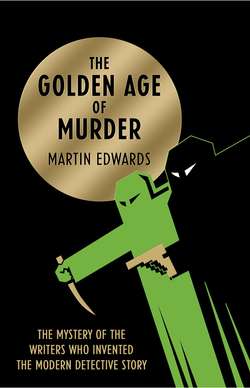Читать книгу The Golden Age of Murder - Stephen Bach, Martin Edwards - Страница 30
Agatha Christie’s notebook 41: extract featuring a story idea based on the Detection Club (by permission of the Christie Archive Trust).
ОглавлениеClub members took a strikingly modern approach to combining self-promotion with supporting a good cause, and four members collaborated in a fundraising event for a hospital charity on 31 May 1932. Berkeley (described in the publicity as the Club Secretary), Bentley, Crofts and Margaret Cole were subjected to a ‘mock trial’ at the London School of Economics, charged with ‘faking the evidence’ by a prosecuting barrister, with a King’s Counsel sitting in judgment.
Less than three months earlier, on 11 March, the Rules and Constitution of the Club had been adopted. They stated that the Club was instituted ‘for the association of writers of detective novels and for promoting and continuing a mutual fellowship between them.’ To promote the Club’s aims, the suitability of every candidate for membership was to be ‘fully and carefully examined’ to ensure that he or she had written ‘at least two detective novels of admitted merit or (in exceptional cases) one such novel; it being understood that the term ‘detective novel’ does not include adventure stories or “thrillers” or stories in which the detection is not the main interest, and that it is a demerit in a detective novel if the author does not “play fair” with the reader.’
Why exclude thriller writers? Christie and many other members wrote thrillers from time to time, and even Sayers had contemplated adding to the mountain of stories about Sexton Blake. The answer was that Sayers and her friends had no time for crude blood-and-thunder merchants. However, the rule did mean that Bentley’s old friend John Buchan, a pillar of the establishment and by a distance the most distinguished British thriller writer, was ineligible for membership, since none of his books could be classed as a detective novel.
In total there were twenty-three rules. They provided that a member who was guilty of a deliberate breach of the rules or damaged the Club’s interests was liable to expulsion. Nobody has ever been expelled, which shows the value of a rigorous approach to recruitment. By the time the Rules and Constitution came into force, there were twenty-eight members. The rules make no provision for ‘Associate Members’, yet Hugh Walpole and Helen Simpson have been described as such in the Club’s list of members. In the list for 1939–40, Walpole is described as an ‘Honorary Member’, as is Sir Norman Kendal, who was not a writer at all, and there is no suggestion that Simpson was not a full member. Presumably this untidiness is due to doubt as to whether Walpole’s psychological thrillers qualified as ‘detective novels’, despite his participation in the Behind the Screen project. Simpson was eminently qualified for full membership, whereas Kendal’s election was a goodwill gesture. One mystery is why the name of R. C. Woodthorpe, elected in 1935, has not appeared in the list of members for the last half-century. Was he thrown out, and his name expunged from the records, for some unspeakable transgression? The likeliest solution is that the omission of his name was a simple mistake.
